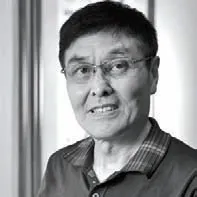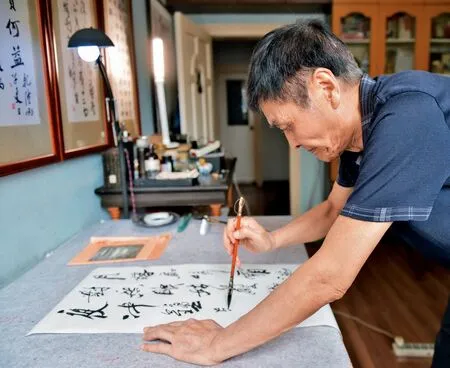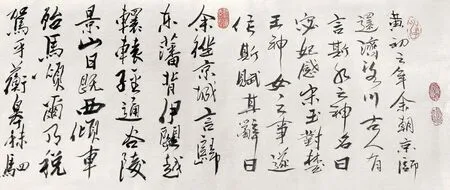杨圭言:翰墨70年
2019-10-19受访者提供
文| 本刊记者 胡 婷 图| 游 宇 受访者提供

杨圭言
1945 年3 月出生于江苏无锡,笔名任南、苏南。早年毕业于徐州师范大学中文系。历任涪陵师专中文系主任、教务处长、党委书记,四川美术学院党委书记,中国人才研究会艺术家学部委员会委员,教授。现任重庆市老年书画研究会副会长、重庆现代禅画院顾问。其书法作品多次在国内外书法大赛中获奖。
今年74 岁的杨圭言,从5 岁开始提笔学字,历经70 年翰墨人生,以自己独有的认识,在笔墨间续写传承,完善着中国传统文化对人格品质的美好向往。
字内功夫
从最初学习颜柳的行、楷入手,继而学习隶、篆,在不断的书法钻研中,杨圭言慢慢形成了自己的风格。他擅长行书,字形融篆、隶、行、草于一炉,笔力遒劲,笔势沉稳,底蕴深厚。
中央美院汤池先生曾撰诗评价杨圭言的书法:“苏南行草走龙蛇,奇正参差气不凡。崩云坠石纸面出,屈铁盘丝腕底来。硬笔老辣多雅趣,隶体清芬少俗埃。勤奋临池善思考,书论嘉卉频频开。”
“对于一个书法家来说,在古人经典书法中锤炼,慢慢就逐渐把自己的理解,融入到作品里去,形成自己比较独特的书法艺术。哪怕里面有一点自己的东西,都很了不起。”以相得益彰的通融手段,去补正自己的认知与追求, 在不断的学习中,杨圭言期冀达到“人书俱老”的境界。

字外功夫
南齐书法家王僧虔在《笔意赞》中提出,“书之妙道,神采为上,形质次之,兼之者方可绍于古人”。
“神采为上”“神形兼备”,逐渐成为传统书法艺术最重要的审美标准。
在杨圭言看来,字难得的是书卷气。而要让书法的黑、白线条富有文化内涵,体现中国传统的精华,需要很多字外功夫。
“比如写《念奴娇·赤壁怀古》,首先,就要了解豪放派词,然后要了解苏东坡写这首词的前因后果,把握他的心境,最后就需要书写者把它化为精神的东西,再融入到书法中。”杨圭言说,“此外,要想让字写得飘逸、豁达,就要学陶渊明的诗。要让字里面有情节、有诗意,脑子里就要装很多唐诗宋词。”
著名艺术评论家史峰曾这样评价杨圭言:把行草书法写得既有规矩,也得性灵,千钧之力的积累,绝对不会变成笔墨的呆板凝滞,而是要归化成风行雨散的疏朗,这就是他的书法风格。天地之间淋笔墨,春风化雨醉儒雅,书法写到这等境界,书卷气息无以复加。
人书合一

01 孟浩然诗二首
人书合一,是书法家渴望的境界。此时,笔墨行进所依据的,不仅是碑帖的法度,也是自然万物的生命律动。
杨圭言说,“书法里不只是那几个字,里面包含了书写人的思想。我们常说字如其人,往往能通过一个人的字,看一个人的性格、修养、格调。”
“如王羲之的《兰亭序》是在‘天朗气清,惠风和畅’,‘群贤兴会’的环境中写成。全幅呈现出平和简静、遒丽天成的风格,字里行间流露出书家悠闲自然、潇洒飘逸的精神风貌,给人以如‘清风出袖,明月入怀’的美感。”杨圭言说,“颜正卿的《祭侄文稿》则是在‘父陷子死,巢倾卵覆’的国难家仇中写成,因而呈现出沉郁流丽、错综复杂的风格。”
经由数十年的临池磨砺,杨圭言将古代书法的快意与潇洒汲取于心,经过师古求法的酝酿,倾注于笔墨,所以执笔使转,最是快意,提摁顿挑,极是自由,依书法而抒情的精神境界,在他的书法里涌涌而溢。

02 《洛神赋》局部
Yang Guiyan: 70 Years of Chinese Calligraphy
Article | Reporter Hu Ting Figures | Provided by You Yu&Interviewees
Yang Guiyan
Yang Guiyan was born in March 1945 in Wuxi, Jiangsu Province, with the pseudonyms of Ren Nan and Su Nan. He graduated from the Department of Chinese Language and Literature of Xuzhou Normal University in his early years. He successively served as the Director, Dean and Secretary of the Party Committee of Department of Chinese Language and Literature of Fuling Teachers College (now Yangtze Normal University); the secretary of the Party Committee of Sichuan Fine Arts Institute; and the member and professor of the Artists Division Committee of the Chinese Talent Research Association. At present, he is the vice-president of Chongqing Senior Painting and Calligraphy Research Association and consultant of Chongqing Modern Zen Painting Academy. His calligraphy works have won many prizes in calligraphy competitions at home and abroad.
Yang Guiyan, 74, began to learn and write Chinese characters at the age of 5. After 70 years of writing Chinese calligraphy, Yang Guiyan, with his unique insight, has inherited and kept passing on the heritage of brush and ink to embody the yearning for virtues in traditional Chinese culture.
Kung Fu in Chinese Characters
Yang Guiyan began to learn the regular script and cursive handwriting by imitating works of Yan Zhenqing and Liu Gongyuan. Later on, he gradually formed his own style by studying the official script and seal script. Well-versed in the cursive handwriting, he has integrated the seal script, official script, cursive script and running hand into his own style, which is powerful with momentum and profound intention.
Mr. Tang Chi of the Central Academy of Fine Arts wrote a poem to comment on Yang Guiyan's calligraphy, "the strokes of calligrapher Su Nan are dancing like dragons and snakes, so extraordinary that they form contrast of grotesqueness and orderliness. Momentum is presented on the paper like collapsing cloud and falling stone; power is released by his wrist like bending iron and twisting wire. His penand-ink calligraphy is sophisticated with elegance; his official script is graceful and extraordinary. Diligent and thoughtful, he came up with new ideas and theories of all kind. "
"For a calligrapher, by facsimileing the ancient classical calligraphy, he will gradually put his own understanding into his works to form an original and unique art of calligraphy of his own. It is worth noting even if there is only a little novelty in his works. "By means of complementing each other, Yang Guiyan has amended his cognition and aim. He keeps learning with the expectation of becoming sophisticated both in handwriting and personality.
Kung Fu Beyond Chinese Characters
Wang Sengqian, a calligrapher in the Southern Qi Dynasty, pointed out in his Comment on Writing that "the quintessence of handwriting is superior in spirit and inferior in form, and only the fusion of them both will inherit the heritage of the ancient".
Therefore, "superior in spirit" and "Excel in both spirit and form" have gradually become the supreme aesthetic standard of Chinese calligraphy.
In Yang Guiyan's view, the essence of calligraphy is the cultural connotation. To embody cultural connotations and reflect traditional Chinese cultural essence with black lines against white paper, one must put a lot of effort beyond the handwriting.

"For example, to writeNiannujiao•Chibi Nostalgia, we should first understand the bold and unrestrained school of Song poems, then know the cause and effect of Su Dongpo's writing this poem by standing in his shoes, and finally turn what we have learned into something spiritual and then put it into calligraphy." Yang Gui said, "In addition, if you want to write with grace and generosity, you should learn Tao Yuanming's poems. If you hope your poems abound in scenarios and poetic elegance, you should memorize more Tang and Song poems."
Famous art critic Shi Feng commented on Yang Guiyan's calligraphy: His cursive handwriting is both orderly and spiritual. The long standing power in his handwriting is never stiff or stagnant, but freehand and relaxing like the shower and breeze. It is his calligraphy style. In a gentle manner, he applies his brushwork and pours the ink like the spring breeze and rain. The spiritual state and cultural manner in his calligraphy is beyond reproach.
Harmony of Calligrapher and Calligraphy
The harmony of calligrapher and calligraphy is a state every calligrapher desires. In such a state, the brush and ink follow not only the stringent laws of calligraphy, but also the laws of life and nature.
Yang Gui said, "Calligraphy is not just about a few characters, it contains the thoughts of the writer. It is said that we can tell a man by his handwriting because it often buries a man's character, manner and style."
"For example, Wang Xizhi's Preface to the Poems Collected from the Orchid Pavilion was written in a clear and sunny day when several virtuous talents gathered up. The calligraphy work shows a peaceful and natural style, and the calligrapher's leisurely and graceful spirit hid between the lines, giving a joyful feeling as if a smooth breeze is caressing one's sleeves and the moonlight is casting on one's chest. Yang Kuei says, "Yan Zhengqing's Manuscript of Mourning My Nephew was written in a background of national calamity and family feud, where the father was set up and the son died, so it presents a melancholy, flowing, and intricate style."
After decades of honing and polishing, Yang Guiyan has fully absorbed the pleasure and chic of ancient calligraphy. By facsimile of the ancient classics and practice, he put what he has gained into his brush and ink, thereby yielding joyful brushwork and freehand style. Therefore, by way of calligraphy, he has adequately expressed his emotions and spiritual world.
